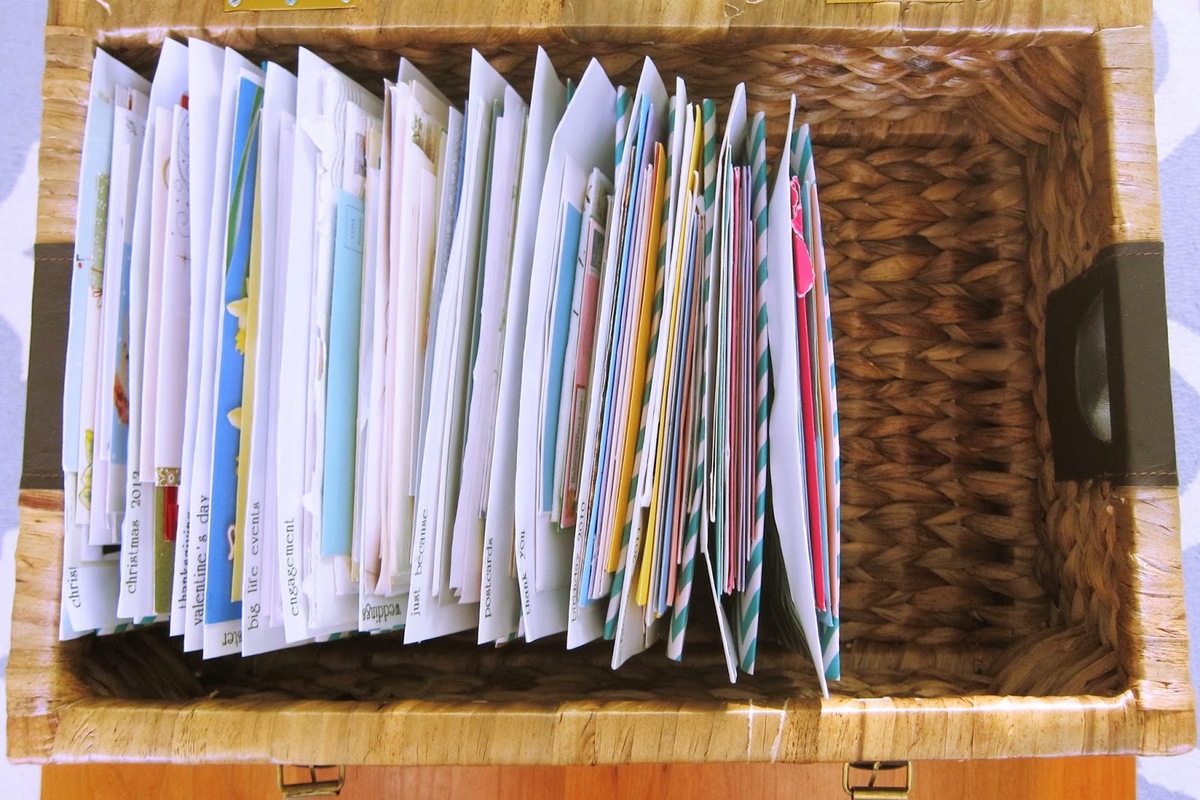

Articles
How To Store Old Pictures
Modified: January 18, 2024
Learn the best methods for storing and preserving your old pictures with our informative articles. Keep your cherished memories safe and long-lasting.
(Many of the links in this article redirect to a specific reviewed product. Your purchase of these products through affiliate links helps to generate commission for Storables.com, at no extra cost. Learn more)
Introduction
Welcome to the digital age, where capturing every precious moment on our smartphones has become second nature. However, amidst the convenience of digital photography, let us not forget the cherished memories captured on old pictures. These snapshots hold a special place in our hearts, preserving moments that are irreplaceable.
Whether it’s a faded family portrait or a stack of nostalgic vacation photos, it’s important to properly store and preserve these old pictures to ensure they stand the test of time. In this article, we will explore the importance of proper picture storage and provide you with essential tips on how to safeguard and preserve your beloved memories.
As time goes by, physical photographs may begin to deteriorate due to factors such as exposure to light, humidity, and mishandling. Additionally, digital photos can also be vulnerable to loss or corruption if not stored correctly. Therefore, taking steps to protect and store both printed and digital photos is crucial for their longevity.
Before diving into the specifics of storing old pictures, it’s vital to understand the significance of preserving these precious memories. Old photos have a unique ability to transport us back in time, evoking emotions and memories that may otherwise fade away. They serve as a tangible link to our past, connecting us to our loved ones, ancestors, and the experiences that have shaped us.
Preserving old pictures also allows us to pass down our personal history to future generations. They can serve as a visual legacy, providing insights into our family’s heritage, traditions, and the stories that define us. By properly storing these pictures, we can ensure that these memories continue to be treasured and shared for years to come.
Now that we understand the importance of preserving old pictures, let’s delve into the necessary steps you should take to prepare your photos for storage.
Key Takeaways:
- Proper storage and preservation of old pictures is crucial for safeguarding cherished memories, connecting us to our past, and passing down our personal history to future generations.
- By understanding the risks, preparing, organizing, and protecting old pictures from environmental factors, we can ensure their longevity and enjoy them for years to come.
Read more: How To Organize Old Pictures
Understanding the Importance of Proper Picture Storage
Proper picture storage is crucial for ensuring the longevity of your beloved memories. By taking the time to store your old pictures correctly, you can protect them from damage and deterioration caused by a variety of factors. Let’s explore why it’s important to store pictures properly and understand the potential risks they face.
Exposure to light is one of the primary culprits behind the deterioration of photographs. Ultraviolet (UV) light, in particular, can cause fading, discoloration, and overall degradation of the image. This is especially true for older, non-digital photos that are more sensitive to light. By storing your pictures in a dark and controlled environment, you can minimize the risk of light damage.
Humidity is another factor that can harm photographs. High levels of humidity can lead to mold and mildew growth, causing irreversible damage to both the image and the physical material. On the other hand, low humidity can result in the drying out and cracking of photos. Controlling humidity levels is essential to prevent moisture-related issues and preserve the quality of your pictures.
Physical handling can also cause damage to old pictures. The natural oils and dirt on our hands can transfer onto the photo surface, leading to stains and smudges. Additionally, mishandling can result in creases, tears, or scratches, greatly diminishing the visual appeal of the picture. By properly storing photos, you can minimize the need for frequent handling, reducing the risk of accidental damage.
In the digital era, we are also faced with the challenge of preserving digital photographs. Digital photos can be vulnerable to loss or corruption due to various factors, such as computer crashes, hardware failure, or accidental deletion. Without proper backup and storage practices, your cherished digital memories could be lost forever. By following the right digital storage techniques, you can protect your digital collection from such risks.
Understanding the potential risks faced by old pictures highlights the importance of proper storage. It is crucial to create an environment that protects your photos from light exposure, controls humidity levels, and minimizes physical handling. Taking these preventative measures will help safeguard your cherished memories, allowing you to enjoy them for years to come.
Now that we’ve explored the significance of proper picture storage, let’s move on to the next step: preparing your photos for storage.
Preparing Your Photos for Storage
Before you can safely store your old pictures, it’s important to take the necessary steps to prepare them for storage. By properly preparing your photos, you can ensure that they remain in excellent condition and are protected from potential damage. Follow these essential tips to prepare your photos for storage:
- Clean your photos: Before placing your pictures into storage, make sure they are clean and free of any debris or dust. Use a soft, lint-free cloth or a gentle brush to remove any dirt or particles from the surface. Avoid using cleaning solutions or liquids, as they may cause damage.
- Handle photos with care: When handling your pictures, always use clean, dry hands to prevent transferring oils or moisture onto the surface. Hold the photos by their edges to avoid touching the image area. If your pictures are delicate or fragile, consider using cotton gloves for added protection.
- Remove adhesive materials: If your old pictures have been stored in albums or frames with adhesive materials, carefully remove them to prevent any damage. Adhesives can cause discoloration, stickiness, and even tearing over time. Use a hairdryer on a low, cool setting to gently warm up the adhesive and carefully lift off the photos.
- Separate sticky photos: If you have photos that have stuck together, do not force them apart. Instead, immerse the stuck photos in a basin of clean, cool water for approximately 10-15 minutes. Gently separate them while they are still submerged, taking care not to tear or damage the emulsion. Once separated, lay them flat to dry on a clean, non-abrasive surface.
- Make copies or scans: Consider creating digital copies or scans of your old photos for extra protection. By having digital backups, you can easily share and preserve your cherished memories. Use a high-quality scanner or rely on professional scanning services for the best results.
By following these steps, you can ensure that your photos are in optimal condition before storing them. Taking the time to properly prepare your pictures will go a long way in preserving their quality and longevity.
Now that you’ve prepared your photos, it’s time to explore the different storage materials available to keep them safe and secure.
Choosing the Right Storage Materials
When it comes to storing your old pictures, selecting the right storage materials is crucial for their long-term preservation. The materials you choose should provide protection against environmental factors, minimize physical damage, and help maintain the quality of your cherished memories. Here are some key considerations when choosing storage materials:
- Acid-free and archival quality: Opt for acid-free storage materials, such as acid-free folders, sleeves, and boxes. Acidic materials can cause photos to deteriorate over time, leading to discoloration and fading. Archival quality materials are specifically designed to be safe for long-term storage and preservation of photographs.
- Archival sleeves and albums: If you prefer to display or organize your photos in albums, choose archival quality sleeves and albums. These sleeves are made of acid-free materials and provide additional protection against moisture, UV light, and physical damage. Look for albums with stable binding and avoid adhesive-backed pages that can damage your photos.
- Storage boxes: Select sturdy, acid-free storage boxes to protect your photos from dust, light, and humidity. These boxes should be made of archival-quality materials and have a lid that fits securely to prevent any external elements from entering. Ensure that the box is large enough to accommodate your photos without bending or overcrowding.
- Dividers and labels: Use acid-free dividers or index cards to separate different sets of photos within your storage boxes. This will help you organize and locate specific pictures more easily. Additionally, labeling your photos with relevant information, such as dates and locations, can be beneficial for future generations to understand the context of the images.
- Digital storage: In addition to physical storage, consider backing up your digital photos in multiple locations. This includes using external hard drives, cloud storage services, or online photo platforms. Make sure to regularly update and maintain backups to guard against any potential loss or damage to your digital collection.
Remember, the goal of choosing the right storage materials is to protect your old pictures from exposure to damaging elements and to provide a controlled environment. By investing in high-quality, archival materials, you can ensure that your photos remain in excellent condition for years to come.
Now that you understand the importance of proper storage materials, the next step is to organize and sort your photos to make them easily accessible.
Organizing and Sorting Your Photos
Organizing and sorting your old photos is an important step in ensuring their accessibility and long-term preservation. By taking the time to arrange your pictures in a systematic and meaningful way, you can quickly locate specific memories and maintain the overall organization of your photo collection. Here are some tips on organizing and sorting your photos:
- Create a system: Establish a system that works for you to organize your photos. This can be based on themes, events, people, or any other categorization that makes sense to you. Consider using a combination of folders, albums, or digital tags to keep your photos organized.
- Sort chronologically: If you have a large collection of photos, sorting them chronologically can be helpful. Start with the oldest or earliest pictures and progress through the years. This can help you track the progression of events and easily locate specific photos based on the time frame.
- Group by events or occasions: Grouping your photos based on events, occasions, or specific milestones can add a narrative element to your collection. This can include family vacations, birthdays, weddings, or any other significant moments. Consider creating separate folders or albums for each event to keep them organized.
- Tag or label your digital photos: If you have a large number of digital photos, take advantage of the tagging or labeling features available in photo management software or applications. Assign tags to specific people, locations, or keywords that will help you search and filter your photos effortlessly.
- Include context and information: As you organize your photos, consider adding context and relevant information. This can include dates, locations, names of individuals, and any other details that will help future generations understand the significance of the photos.
- Regularly review and update: Over time, your photo collection may grow, and new memories may be added. Schedule periodic reviews to ensure that your organization system is up to date and make any necessary adjustments or additions to keep your collection well-organized.
By implementing these tips, you can create a well-organized and easily accessible photo collection. Organizing and sorting your photos not only helps you find specific memories more efficiently but also ensures that your collection remains in order for future generations to enjoy.
Now that your photos are organized, it’s time to explore the best storage methods for printed photos and digital photos separately.
Store old pictures in acid-free photo albums or archival boxes to protect them from damage. Keep them in a cool, dry place away from sunlight and humidity.
Read more: How To Make Old Windows Into Picture Frames
Storing Printed Photos
Printed photos hold a special place in our hearts, capturing moments in time that we can physically hold and cherish. To preserve the quality and longevity of your printed photos, it’s important to store them properly. Here are some methods you can use to store your printed photos:
- Use acid-free photo albums: Acid-free photo albums provide a safe and protective environment for your printed photos. Look for albums with archival-quality sleeves or pockets that are made from acid-free materials. Avoid adhesive-backed albums or albums with PVC or vinyl pages, as they can cause damage and deterioration to your photos over time.
- Place photos in acid-free storage boxes: If you have loose printed photos that you want to store, consider using acid-free storage boxes. These boxes provide a dark, dry, and controlled environment to protect your photos from light, dust, and other environmental factors. Ensure that the box is sized appropriately to prevent overcrowding and potential damage to the photos.
- Separate photos with acid-free dividers: If you have multiple sets of photos within an album or storage box, use acid-free dividers or index cards to separate them. This helps avoid any potential friction or damage that can occur when photos rub against each other.
- Avoid using paperclips or rubber bands: When storing printed photos, never use paperclips or rubber bands to hold them together. These can leave marks, cause indentations, or even damage the surface of the photos. Instead, use acid-free photo corners or sleeves to keep them in place without causing harm.
- Store photos in a cool, dry place: It’s important to store your printed photos in a location with stable temperature and humidity levels. Avoid areas prone to extreme temperature changes, such as attics, basements, or near windows. Excessive heat and humidity can accelerate the deterioration of your photos.
- Keep photos away from light: Exposure to light can fade and discolor your printed photos over time. Store them in a dark or low-light environment, away from direct sunlight and bright overhead lighting. If you choose to display certain photos, consider using UV-filtering glass or frames to protect them from harmful ultraviolet (UV) rays.
Remember to handle your printed photos with clean, dry hands and avoid touching the surface of the images. By following these storage methods, you can help ensure that your printed photos remain in excellent condition and can be enjoyed for generations to come.
Now that you know how to store your printed photos, let’s move on to the storage of digital photos.
Storing Digital Photos
In the digital age, many of our cherished memories are captured and stored as digital photos. To ensure the long-term preservation and accessibility of your digital photo collection, it’s important to adopt proper storage practices. Here are some methods to store your digital photos:
- Backup your photos: Creating backups of your digital photos is crucial to protect them from loss or corruption. Invest in multiple storage options, such as external hard drives, cloud storage services, or online photo platforms. This redundancy ensures that even if one storage solution fails, you can still recover your precious memories from another source.
- Organize your digital files: Keep your digital photos organized in a logical file structure on your computer or external hard drive. Create folders and subfolders based on themes, dates, events, or any classification that works best for you. This way, you can easily locate specific photos when you need them.
- Use metadata and tags: Leverage the power of metadata to add valuable information to your digital photos. Include details such as dates, locations, people, or keywords in the file’s properties or use photo management software that allows you to add tags. This will make it easier to search and filter your photos when you’re looking for specific images.
- Maintain file formats: When saving or exporting your digital photos, choose file formats that are widely supported and have good compression without significant loss of quality, such as JPEG or PNG. Avoid using overly compressed or proprietary file formats that could potentially become obsolete in the future.
- Secure your digital storage: Ensure the security of your digital storage by using strong passwords, encryption, and regularly updating your security software. This will help protect your digital photos from unauthorized access and potential loss or damage due to malware or cybersecurity threats.
- Regularly check and update your backups: Periodically verify the integrity of your backup files and ensure that your backup devices are functioning properly. Regularly update your backups to include any new photos you’ve added to your collection. This will help ensure that your digital photos are well-preserved and up to date.
Additionally, consider sharing your digital photos with trusted family members or friends and creating a comprehensive plan for the future of your digital photo collection. This can include instructions for accessing backups and sharing the responsibility of maintaining and preserving your digital memories.
By following these storage methods, you can ensure the longevity and accessibility of your digital photo collection, preserving your cherished memories for years to come.
Now that you know how to store both your printed and digital photos, let’s explore the best practices for protecting your photos from environmental factors.
Protecting Photos from Environmental Factors
Environmental factors can pose risks to the long-term preservation of both printed and digital photos. By taking steps to protect your photos from these elements, you can ensure their continued quality and longevity. Here are some measures you can take to safeguard your cherished memories:
- Avoid extreme temperatures: High temperatures can cause physical damage to printed photos, leading to color fading, warping, or adhesive deterioration. Likewise, extreme cold temperatures can make physical materials brittle. Store your printed photos in a cool, stable environment with temperatures between 60°F and 70°F (15°C and 21°C).
- Control humidity levels: High humidity can lead to mold, mildew, and moisture damage, while low humidity can cause photos to become brittle. Maintain a relative humidity level between 35% and 55% to minimize the risk of detrimental moisture-related effects. Consider using dehumidifiers, humidity monitors, or desiccants to regulate humidity levels in storage areas.
- Protect from light exposure: Exposure to light, particularly ultraviolet (UV) light, can cause fading, discoloration, and deterioration of both printed and digital photos. Store printed photos and keep digital devices away from direct sunlight or bright fluorescent lighting. Consider using UV-filtering glass or screens for framed photos, and avoid displaying electronic devices in overly bright settings.
- Shield from dust and dirt: Dust and debris can accumulate on photos, leading to surface scratches and damage. Keep your stored photos in acid-free sleeves, albums, or storage boxes to protect them from dust. Regularly clean the storage containers to prevent the buildup of dirt and particles.
- Be mindful of air quality: Airborne pollutants, such as smoke, can negatively affect printed photos. Avoid storing photos in areas prone to smoke exposure and maintain good indoor air quality. If display or storage areas have a higher risk of pollution, consider using air purifiers to reduce the impact of pollutants on your photos.
- Protect digital devices from damage: Digital photos are susceptible to damage if the devices containing them are not properly cared for. Keep your digital devices, such as computers, external hard drives, or memory cards, in protective cases or bags when not in use. Avoid exposing them to extreme temperatures and handle them with care to minimize the risk of physical damage.
- Regularly back up digital photos: Protect your digital photo collection from the risk of loss or corruption by regularly backing up your files to multiple storage locations. This ensures that even if one storage medium fails, your photos will still be preserved. Consider using cloud storage services or external hard drives to keep your backups secure and accessible.
By implementing these measures, you can significantly reduce the risks that environmental factors pose to your photos. Protecting your photos from temperature fluctuations, humidity, light exposure, dust, and pollutants will help maintain their quality and ensure their preservation for years to come.
Now that you know how to protect your photos, let’s explore some additional tips for long-term storage of old pictures.
Tips for Long-Term Storage of Old Pictures
When it comes to storing old pictures for the long term, taking additional precautions can further ensure their preservation and quality. By following these tips, you can create an optimal storage environment and safeguard your cherished memories for future generations:
- Store duplicates in separate locations: Consider making duplicate copies of your most precious photos and storing them in separate locations. This provides an extra layer of protection in case of unforeseen events such as fire, flood, or theft.
- Use archival-quality materials: Opt for archival-quality storage materials such as acid-free folders, sleeves, albums, and boxes. These materials are specifically designed to be safe for long-term photo storage and help prevent damage caused by acids or contaminants.
- Keep photos in a stable environment: Choose a storage location that maintains a consistent temperature and humidity level. Fluctuations in these factors can accelerate the deterioration of photos. Avoid areas prone to temperature extremes, such as attics or basements, and opt for a cool, dry, and dark room instead.
- Handle photos with care: Always handle your photos with clean, dry hands to avoid transferring oils, dirt, or moisture onto the surface. Hold photos by their edges to minimize contact with the image area. Consider using cotton gloves for added protection when handling delicate or valuable prints.
- Regularly inspect stored photos: Periodically check on your stored photos to ensure they remain in good condition. Look for signs of deterioration, such as discoloration, mold, or physical damage. Address any issues promptly and consider seeking professional assistance if needed.
- Keep photos away from magnetic fields: Avoid storing photos near magnetic sources, such as speakers or electronic devices, as magnets can potentially damage the magnetic layers of old photos or printed materials.
- Digitize old and fragile photos: For extra protection, consider digitizing your old and fragile photos. This process not only allows you to create backup copies but also provides an opportunity to repair and enhance the original digital files without compromising the physical prints.
- Create a detailed inventory: Maintain a detailed inventory of your photo collection, noting important details such as dates, locations, and people depicted. This inventory will not only help you keep track of your photos but also assist future generations in understanding the significance of the images.
- Keep up with technological advancements: Stay informed about new storage technologies and methods that may arise over time. As digital storage options evolve, consider migrating your digital photo collection to newer formats or platforms to ensure compatibility and accessibility in the future.
By implementing these tips, you can significantly enhance the preservation of your old pictures and ensure that they remain intact for years to come. Remember, the key is to provide a stable and controlled environment while handling and storing your photos with care.
Now that you have a comprehensive understanding of how to store and protect your old pictures, you can embark on preserving your precious memories and sharing them with future generations.
Protecting and preserving old pictures is not just about maintaining physical or digital files; it’s about safeguarding the memories and stories that form the threads of our personal history.
Read more: What To Do With Old Picture Frames
Conclusion
Preserving and protecting our old pictures is not only about preserving the physical or digital files themselves but also about safeguarding the memories and stories they hold. These cherished snapshots connect us to our past, our heritage, and the experiences that have shaped us. By taking the time to properly store and protect our old pictures, we ensure that these memories remain intact for generations to come.
In this article, we have explored the importance of proper picture storage and provided valuable tips for storing both printed and digital photos. We have discussed the significance of understanding the potential risks our photos face, such as light exposure, humidity, and physical handling, and we have shared information on how to mitigate these risks through the use of appropriate storage materials and environmental controls.
We have also delved into the essential steps for preparing old photos for storage, including cleaning them, handling them with care, and making digital copies or scans. Additionally, we have emphasized the importance of organizing and sorting our photos to make them easily accessible and enjoyable to revisit.
Furthermore, we have covered the specific storage methods for printed photos, such as using acid-free albums and storage boxes, as well as addressing the importance of properly storing digital photos, including backing them up and organizing them with metadata and tags.
Recognizing the potential threats posed by environmental factors, we have provided guidance on protecting our photos from light exposure, dust, humidity, and temperature fluctuations. By implementing these measures, we can help safeguard our cherished memories from deterioration and preserve their quality for years to come.
To ensure the long-term preservation of our photo collection, we have offered tips such as storing duplicates in separate locations, using archival-quality materials, and maintaining a stable storage environment. Furthermore, we have emphasized the importance of regularly inspecting our stored photos, handling them with care, and considering the digitization of old and fragile prints.
Remember, our old pictures hold not only visual images but also the stories, emotions, and connections that give life to our personal history. By taking the time to properly store and protect these memories, we honor the value they hold and ensure that they can be cherished and shared for generations to come.
So, dig out those old photo albums, organize your digital collection, and embark on the journey of preserving your precious memories. Your future self and the generations that follow will be grateful for the effort and care you put into safeguarding these irreplaceable pieces of your personal story.
Frequently Asked Questions about How To Store Old Pictures
Was this page helpful?
At Storables.com, we guarantee accurate and reliable information. Our content, validated by Expert Board Contributors, is crafted following stringent Editorial Policies. We're committed to providing you with well-researched, expert-backed insights for all your informational needs.














0 thoughts on “How To Store Old Pictures”